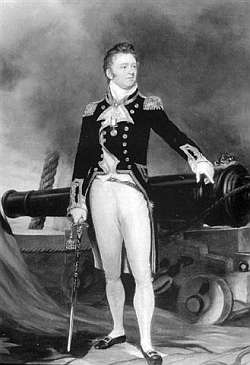- Author
- A.N. Other and NHSA Webmaster
- Subjects
- 19th century wars, Ship histories and stories
- Tags
-
- RAN Ships
- None noted.
- Publication
- December 2007 edition of the Naval Historical Review (all rights reserved)
‘And as the war they did provoke,
We’ll pay them with our cannon;
The first to do it will be BROKE,
In the gallant ship the SHANNON’*
When the United States declared war on the British in June of 1812, the Royal Navy was at the height of its power and glory. After decades of war against a variety of continental enemies, she was rightly regarded as undisputed master of the seas. No serious challenge to the supremacy of the Royal Navy had been mounted since the Battle of Trafalgar, in 1805. Indeed Trafalgar itself had simply been the last in a long list of great British victories at sea. Despite this success (or perhaps because of it), the British government was initially reluctant to enter another war, still having their hands full dealing with Napoleon’s armies in Europe. The British Government regarded the American problem as an annoying distraction, and certainly did not rate the infant, and comparatively tiny, navy of the United States as a credible threat.
In the first six months of the war, the Americans won a series of decisive victories in single ship actions. This was a complete shock to both the British people and the Royal Navy, who shared absolute confidence in their invulnerability in both ships and men.. The Americans had recently built a small number of powerful 44 gun frigates, which were heavier in displacement, threw a heavier broadside and carried substantially greater crews than equivalent British frigates. The British were quick to attribute these defeats to overwhelming superiority of firepower alone; however, the Americans had trained intensively and were both confident and aggressive.

(Image:Chesapeake Mill Ltd)
One of the British frigates on the American station was HMS Shannon. Built in 1806, she rated 38 guns and was typical of British frigates of her era. Since commissioning, she had been commanded by Captain Phillip Bowes Vere Broke. Broke longed for action, and for the past seven years, had rigorously trained his men in both small arms and cannonry. His crew was superbly disciplined and had complete faith in their officers. Broke even refused to dispatch prize crews to return captured vessels to safe ports, preferring to sink the prizes rather than weaken his crew in case of possible battle
Achievements
On 1st June 1813, Broke, laying off Boston Harbour, sent a written challenge to the newly appointed Captain James Lawrence of the USS Chesapeake, inviting him to a single ship challenge at the time and place of his choosing. The Chesapeake (38 guns), was probably the closest matched of the American frigates, although was slightly heavier and carried a larger crew on board. Lawrence, who had not yet received the challenge, had already decided to accept combat and sailed out to fight. The Americans believed victory was assured and had prepared a victory feast in Boston. A number of pleasure craft had sailed out to witness another British ship being beaten, and onlookers gathered on the shore to witness the spectacle.
The two ships joined battle at 5.50 pm on that day, and what followed was probably the most ferocious single ship action of the age. The gun battle lasted just 11 minutes. In that time, the Shannon hit Chesapeake with 362 cannon shot (all told), and was struck by 158 in return. Captain Lawrence was shot and mortally wounded. As he was carried below, he famously cried, ‘Don’t give up the ship!’ By the time the Chesapeake struck her colours, four minutes after being boarded by the British, her casualties included 61 killed, 85 wounded. The Shannon herself lost 33 killed, 50 wounded, more than HMS Victory suffered in six hours at Trafalgar. Broke himself was cut down late in the battle, receiving a critical head wound from an American cutlass, as he led the boarding action which ultimately took the ship.
‘This was the finest single-ship action in the history of war at sea under sail’
A. Lambert
Philip Broke renewed the public’s faith in the capabilities of the Royal Navy, and reinvigorated morale within the service. No other frigate captain received such high honours, or such public acclaim, for a single-ship action. Upon his return to England, Broke was made a baronet, a more prestigious peerage than Nelson received for victory at the battle of the Nile. The second and third lieutenants, Wallis and Falkiner respectively, were both deservedly promoted to Commander. Two midshipmen and the sailing master were also promoted to Lieutenant.




